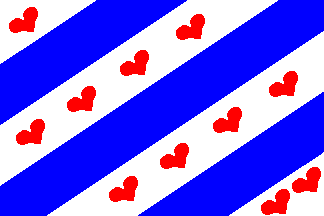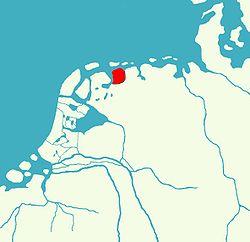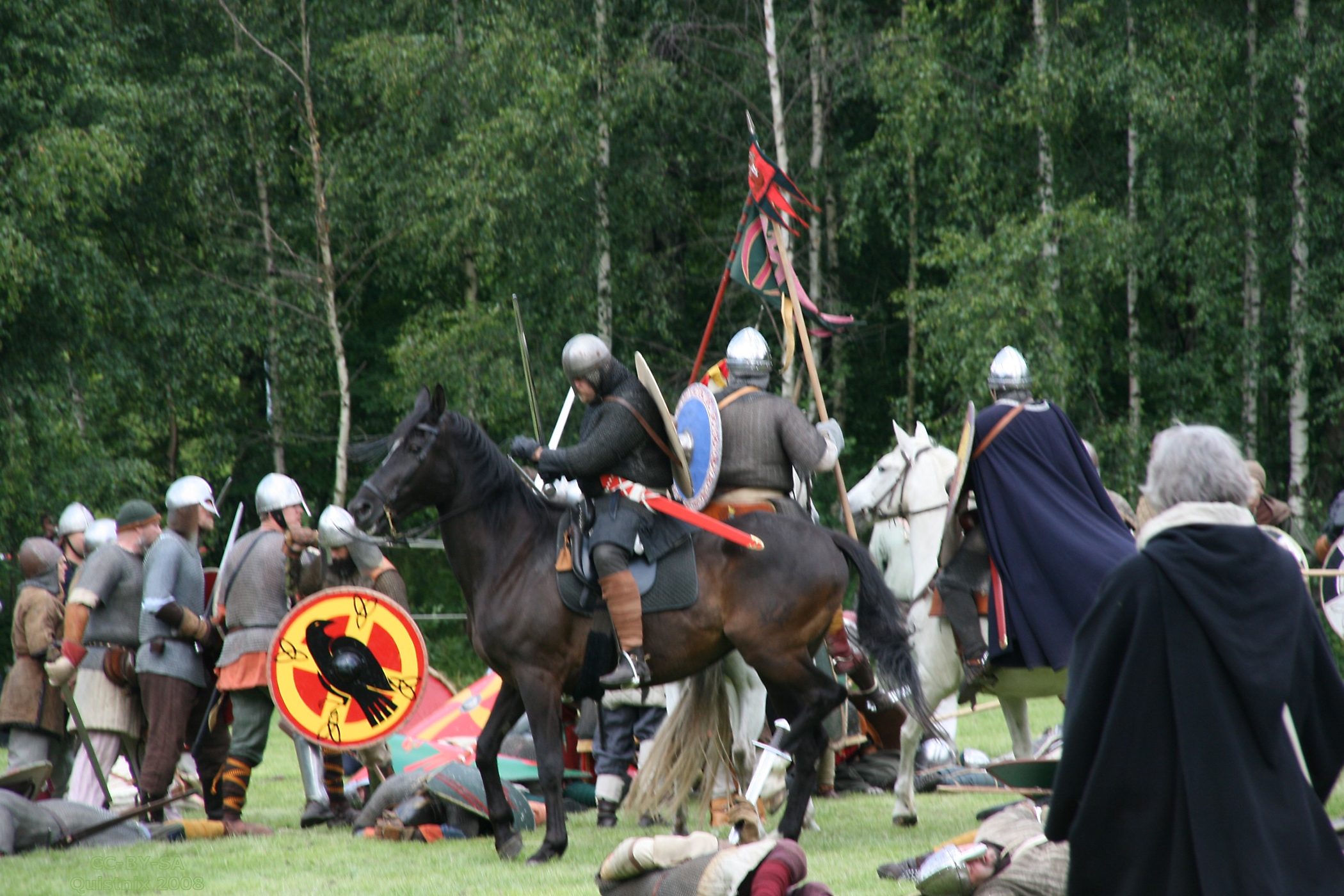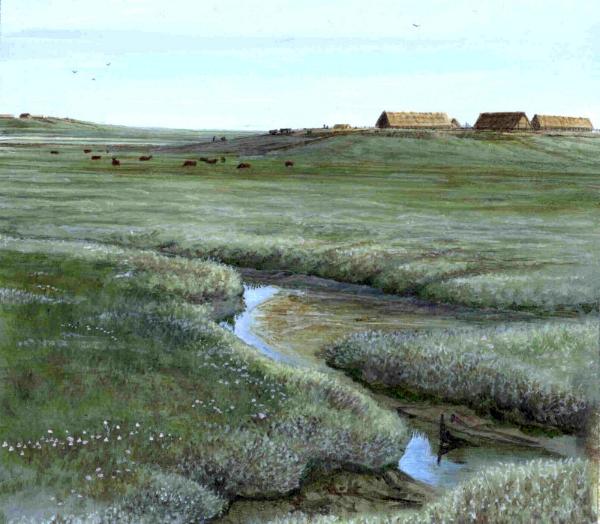Éadric
Knight at Arms

In which I offer a modest case for a Frisian faction.
Frisians in the time around 1066
After the Frisians were defeated by the Franks in the eighth century AD, Frisia became part of the Frankish Empire (subsequently the Holy Roman Empire) and was ruled by counts and such loyal to the Emperor. Yet these counts never had much reign over the Frisians. Unlike in most other places in Europe a feudal nobility never really developed in Frisia. Instead, as inherited from old Germanic times, most of the power lay in the hands of the allodial landowners, of whom some of the most important ones bore the title háveding ‘chieftain’ (also hávedling, háudling, etc.; cf. Old Norse höfðingi).
And so, after the killing of count Arnulf in 993 and especially after the killing of margrave Henry in 1101, the so-called Frisian Freedom was established, in which the Frisians acknowledged loyalty only directly to the Emperor. By 1248 this status aparte was formally recognized by the Emperor. Most likely it was informally recognized much earlier.
In the centuries that followed the hávedingar would go on to gain power. Yet in the absence of a single ruler of Frisia and in the presence of powerful Saxon and Burgundian dukes eyeing Frisia, and with the (Saxon) city of Groningen expanding its influence, Frisia came to know many internal struggles, until at the end of the fifteenth century Albert III, Duke of Saxony became governor of Frisia. With that the Frisian Freedom was no more.
Frisians in Víkingr
In the year 1066 Frisia was still organised under central rule, albeit not very effectively. The Frisians did not have a military as organised as that of the Anglo-Saxons, Norwegians, Normans and Rus, but would certainly have been able to give a good fight, without too much technological inferiority.
As far as I know a Frisian army would not have different classes such as fyrdmen and húscarlas, but simply fighters ranging from poorly to well equipped, depending on what they could afford. The Frisians did have fame for breeding very strong warhorses (the ancestors of the modern Friesian horse), which they undoubtedly used themselves as well in battle. But their cavalry would of course not been as impressive as that of the Normans.
What classes then could would any Frisian warband or army consist of? The first and fourth class pose no problem. They would be the sketta ‘archer’ (cf. Old English scytta and Old Norse skyti) and the háveding ‘chieftain’ (cf. Old Norse höfðingi). The sketta would have access to modest bows, like the Saxon scytta, while the háveding would most likely be mounted. Things get tricky when we have to decide on the nature and names of the second and third class, for we know little about the specifics of Frisian military organisation. It does however seems safe to assume that it was much like that of the Saxons and Frankish/French, only more modest.
I would propose to make the second class a general footsoldier and call him either a ferdman or a hereman. Neither of these names have been attested in Old Frisian. However, a common word was hereferd ‘military expedition, campaign’, a compound of here ‘army’ (cf. Old English here ‘army, host’ and Old Norse herr ‘army, host’) and ferd ‘expedition’ (cf. Old English fyrd). Since Frisian armies seem to have been formed in an ad hoc manner, it would seem that able bodied men fighting battles (and most likely volunteering for it) would usually be in some kind of expedition for the occasion. Ferdman would also be cognate to Old English fyrdman, only with a different meaning. The other option, hereman, speaks for itself. It simply means ‘army man’. It would certainly have been understood by Frisians at the time. (A third option is the firmly attested word herenát ‘comrade in arms’, but this is most likely too general a description.) The equipment of this second class would be very much like that of the Anglo-Saxon fyrdman.
For the third class I propose to make a fighter that can be either footsoldier or a horseman. He would not have a horse by default, but he would be able to buy one (at a low price, since the Frisians were famed breeders of warhorses), and his armour would not be as fancy as that of the Normans riders. The Frisians would then be the only faction with such an ambiguous third class. They’d have less horses than the Normans, but, naturally, more than the Saxons and Vikings. Naming this class then is a bit of a challenge. For lack of a better word I propose we call this class the wígand ‘warrior’. It’s more of a place-holder term, since we simply don’t know what they would have been called. It’s better than nothing.
I’ve emailed a professor of Old Frisian for help in the matter of these names. He’s out of office for the next two weeks, so I hope we’ll get some feedback later this month.
Deciding on the banner is also a challenge. A version of the modern Frisian flag was first recorded at the end of the Middle Ages, apparently in some French heraldry book, as the banner of the “King of Frisia” (while none existed). The modern Frisian flag has four blue and three white diagonal bars as well as seven red coloured leaves of the yellow water-lily. These leaves, resembling hearts, would represent the legendary Seven Sealands of Frisia – seven probably being more a symbolical than an actual number. The motif of blue and white bars and red items is older though, as parallels can be found in Scandinavian banners. Leaves of the yellow water-lily are also found and mentioned elsewhere in Northern-Europe, from at least the year 1200.
An older Frisian banner was blue with two yellow lions and white coins. In a slightly altered form it has since become the flag of West-Friesland, a small region in North-Holland. And an even older Frisian banner, known only from legend and apparently wholly red, was the so-called Magnus banner. Supposedly it belonged to Fríso, the ancestral father of the Frisian, and was magical. It was buried for centuries and after being found again given to the legendary Frisian banner bearer and hero Magnus Forteman. It was however buried again, never to be found again.
I would opt for a version of the modern Frisian flag. Examples of the mentioned flags are below, behind the 'spoiler button'.
To sum it up, this is what the Frisian classes would look like.
Frísa 'Frisians'
[list type=decimal][*]Sketta ‘archer’
[*]Ferdman ‘expedition man’
[*]Wígand ‘warrior’
[*]Háveding ‘chieftain’[/list]

Modern flag of Frisia

Modern flag of the Ommelanden (which is closest to the oldest recorded form)

Modern flag of West-Friesland
Frisians in the time around 1066
After the Frisians were defeated by the Franks in the eighth century AD, Frisia became part of the Frankish Empire (subsequently the Holy Roman Empire) and was ruled by counts and such loyal to the Emperor. Yet these counts never had much reign over the Frisians. Unlike in most other places in Europe a feudal nobility never really developed in Frisia. Instead, as inherited from old Germanic times, most of the power lay in the hands of the allodial landowners, of whom some of the most important ones bore the title háveding ‘chieftain’ (also hávedling, háudling, etc.; cf. Old Norse höfðingi).
And so, after the killing of count Arnulf in 993 and especially after the killing of margrave Henry in 1101, the so-called Frisian Freedom was established, in which the Frisians acknowledged loyalty only directly to the Emperor. By 1248 this status aparte was formally recognized by the Emperor. Most likely it was informally recognized much earlier.
In the centuries that followed the hávedingar would go on to gain power. Yet in the absence of a single ruler of Frisia and in the presence of powerful Saxon and Burgundian dukes eyeing Frisia, and with the (Saxon) city of Groningen expanding its influence, Frisia came to know many internal struggles, until at the end of the fifteenth century Albert III, Duke of Saxony became governor of Frisia. With that the Frisian Freedom was no more.
Frisians in Víkingr
In the year 1066 Frisia was still organised under central rule, albeit not very effectively. The Frisians did not have a military as organised as that of the Anglo-Saxons, Norwegians, Normans and Rus, but would certainly have been able to give a good fight, without too much technological inferiority.
As far as I know a Frisian army would not have different classes such as fyrdmen and húscarlas, but simply fighters ranging from poorly to well equipped, depending on what they could afford. The Frisians did have fame for breeding very strong warhorses (the ancestors of the modern Friesian horse), which they undoubtedly used themselves as well in battle. But their cavalry would of course not been as impressive as that of the Normans.
What classes then could would any Frisian warband or army consist of? The first and fourth class pose no problem. They would be the sketta ‘archer’ (cf. Old English scytta and Old Norse skyti) and the háveding ‘chieftain’ (cf. Old Norse höfðingi). The sketta would have access to modest bows, like the Saxon scytta, while the háveding would most likely be mounted. Things get tricky when we have to decide on the nature and names of the second and third class, for we know little about the specifics of Frisian military organisation. It does however seems safe to assume that it was much like that of the Saxons and Frankish/French, only more modest.
I would propose to make the second class a general footsoldier and call him either a ferdman or a hereman. Neither of these names have been attested in Old Frisian. However, a common word was hereferd ‘military expedition, campaign’, a compound of here ‘army’ (cf. Old English here ‘army, host’ and Old Norse herr ‘army, host’) and ferd ‘expedition’ (cf. Old English fyrd). Since Frisian armies seem to have been formed in an ad hoc manner, it would seem that able bodied men fighting battles (and most likely volunteering for it) would usually be in some kind of expedition for the occasion. Ferdman would also be cognate to Old English fyrdman, only with a different meaning. The other option, hereman, speaks for itself. It simply means ‘army man’. It would certainly have been understood by Frisians at the time. (A third option is the firmly attested word herenát ‘comrade in arms’, but this is most likely too general a description.) The equipment of this second class would be very much like that of the Anglo-Saxon fyrdman.
For the third class I propose to make a fighter that can be either footsoldier or a horseman. He would not have a horse by default, but he would be able to buy one (at a low price, since the Frisians were famed breeders of warhorses), and his armour would not be as fancy as that of the Normans riders. The Frisians would then be the only faction with such an ambiguous third class. They’d have less horses than the Normans, but, naturally, more than the Saxons and Vikings. Naming this class then is a bit of a challenge. For lack of a better word I propose we call this class the wígand ‘warrior’. It’s more of a place-holder term, since we simply don’t know what they would have been called. It’s better than nothing.
I’ve emailed a professor of Old Frisian for help in the matter of these names. He’s out of office for the next two weeks, so I hope we’ll get some feedback later this month.
Deciding on the banner is also a challenge. A version of the modern Frisian flag was first recorded at the end of the Middle Ages, apparently in some French heraldry book, as the banner of the “King of Frisia” (while none existed). The modern Frisian flag has four blue and three white diagonal bars as well as seven red coloured leaves of the yellow water-lily. These leaves, resembling hearts, would represent the legendary Seven Sealands of Frisia – seven probably being more a symbolical than an actual number. The motif of blue and white bars and red items is older though, as parallels can be found in Scandinavian banners. Leaves of the yellow water-lily are also found and mentioned elsewhere in Northern-Europe, from at least the year 1200.
An older Frisian banner was blue with two yellow lions and white coins. In a slightly altered form it has since become the flag of West-Friesland, a small region in North-Holland. And an even older Frisian banner, known only from legend and apparently wholly red, was the so-called Magnus banner. Supposedly it belonged to Fríso, the ancestral father of the Frisian, and was magical. It was buried for centuries and after being found again given to the legendary Frisian banner bearer and hero Magnus Forteman. It was however buried again, never to be found again.
I would opt for a version of the modern Frisian flag. Examples of the mentioned flags are below, behind the 'spoiler button'.
To sum it up, this is what the Frisian classes would look like.
Frísa 'Frisians'
[list type=decimal][*]Sketta ‘archer’
[*]Ferdman ‘expedition man’
[*]Wígand ‘warrior’
[*]Háveding ‘chieftain’[/list]

Modern flag of Frisia

Modern flag of the Ommelanden (which is closest to the oldest recorded form)
Modern flag of West-Friesland

















